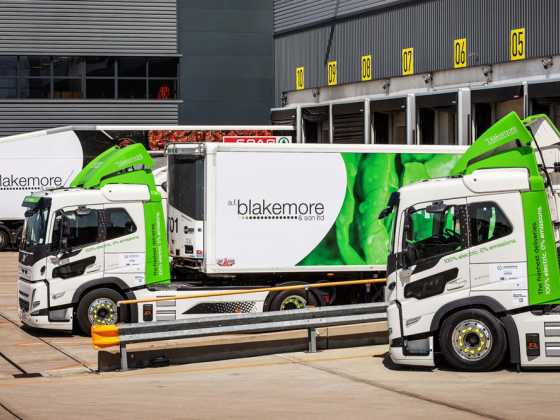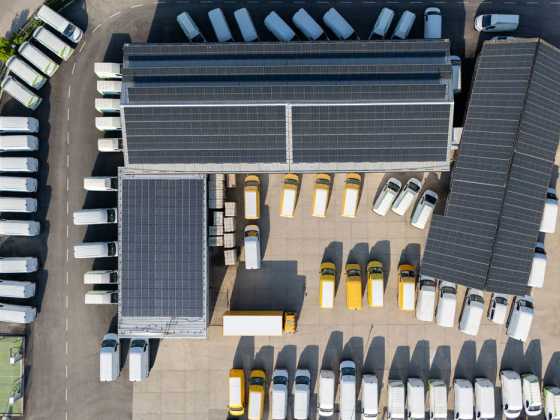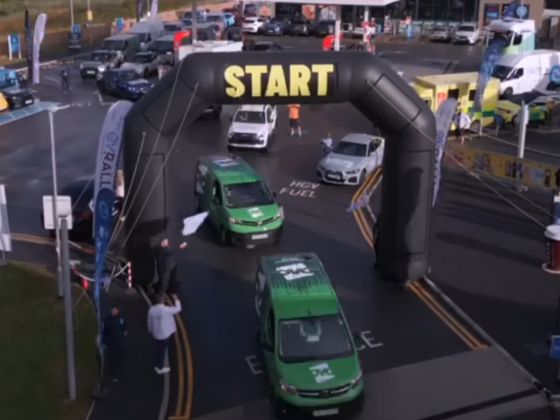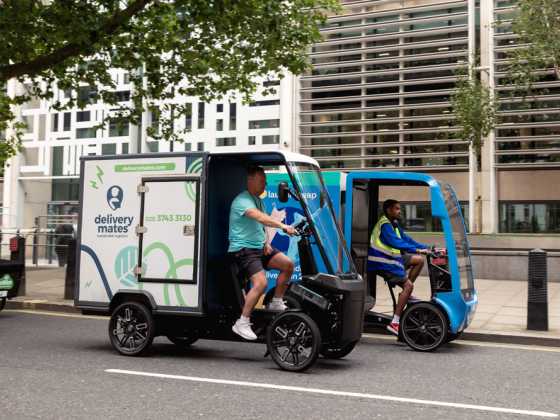Sparks fly in Frankfurt as electric cars take centre stage
On 15 September, the latest models and concepts shone their headlights upon Frankfurt for one of the world’s leading motor shows. With electrification being one of the main themes of the show, GreenFleet looks in the rear view mirror and reviews the latest cars that impressed in Germany
 Organised by the German Association of the Automotive Industry and held every two years on rotation with the Paris motor show, Frankfurt is the home event for the all‑powerful German car manufacturing industry. Held in the halls of the Messe exhibition centre, the show is known for the tightly-fought contest between BMW, Mercedes and Volkswagen, who each showcase their latest product lines in an attempt to gain ground in an ever increasingly tight market.
Organised by the German Association of the Automotive Industry and held every two years on rotation with the Paris motor show, Frankfurt is the home event for the all‑powerful German car manufacturing industry. Held in the halls of the Messe exhibition centre, the show is known for the tightly-fought contest between BMW, Mercedes and Volkswagen, who each showcase their latest product lines in an attempt to gain ground in an ever increasingly tight market.
Headlines were captured by Jaguar, who broke the world record for the largest loop-the-loop with its new and eagerly-awaited F-Pace SUV. Expected to hit UK showrooms in April next year with an entry‑level price of just over £34,000, the F-Pace will be available in both petrol and diesel versions. An aluminium structure and a 2.0-litre ‘Ingenium’ diesel’ promises low NOx and CO2 emissions from 129g/km.
Noticeable European models
While the Frankfurt Motor Show is a great opportunity for the German car manufacturers to take centre stage and flex their muscle, there were some other noticeable new models that impressed from elsewhere across the continent.
While the Lamborghini Huracan Spider and Ferrari 488 Spider shone through the camera flashes, Renault and Vauxhall gained admiration with their latest models, the Astra and Mégane respectively. Due to go on sale in November this year, the Astra Hatch possesses new adaptable LED matrix headlamps and a more sporty outlook. Additionally, there will be entry‑level 1.4, three turbocharged petrols; a sub-100g/km three-cylinder 1.0-litre, a E powerful 1.6, and an all-new 1.4‑litre ECOTEC turbo unit offering up to 250Nm (184lb ft) of torque.
Renault continued its design revolution by unveiling the new family hatch Mégane. Internally, a variety of set-ups are expected to be offered, with the entry-level car possessing a conventional dot-matrix central display and higher-spec cars offering a choice of seven or nine-inch portrait touchscreens.
Alfa Romeo were an unexpected hit at the show, after unveiling the new Alfa Romeo Giulia Quadrifoglio (QV) ahead of its autumn release next year. The first of its kind since the demise of the 159, Alfa Romeo are using the Giulia to reinstate its place among the major European players. The figures are nearly as exciting as the models look: a 503bhp turbocharged 3.0‑litre V6 means the QV can hit 0-62mph in just 3.9 seconds.
The more mainstream non-QV version of the Giulia will take to the stage at the Geneva motor show in March, but it appears Alfa Romeo has done enough to whet the appetite of many of the company’s previous doubters.
The Crossover trend
Offering plenty of practicality with fairly low running costs, crossovers and SUVs dominated the Frankfurt floor. Despite the 4x4 looks, the majority of crossovers remain front-wheel drive only, ensuring that they are much more suited to driving on the road than traditional SUVs.
One crossover gaining plenty of admirers was the Audi e-tron quattro, a 4x4 EV which can be charged up in just half an hour. With rumoured production scheduled for 2018, many visitors were left purring over the potential for a forthcoming Audi Q6 e-tron to its SUV range.
Elsewhere, Toyota gave delegates plenty to ponder by unveiling its concept for a hybrid crossover. The C-HR is a near production preview and will be fully unveiled at the 2016 Geneva motor show, before sale later in the year. With a more angular and coupe-like design in keeping with the style-led small crossover market, the C-HR represents a shift from the previous three‑door to a five-door format, with a full hybrid petrol-electric powertrain also expected.
Challenging Tesla’s domination
Not many manufacturers can match Tesla’s rise to domination. Having firmly established itself as the leader in the premium electric car market, the Frankfurt motor show revealed plenty of rivals to the American car giants.
Most noticeably, the new 600bhp all‑electric Porsche Mission E was widely heralded. The Stuttgart based company claim that the Mission E will pass 62mph in ‘less than 3.5 seconds’, dashing past 124mph in just over ten seconds, with the top speed expected to exceed 155mph. Former chief Matthias Mueller stated that an 80 per cent charge would take less than a quarter of an hour, making refuelling rather like ‘fast pit stops’. Eager to establish itself at the top of the electric vehicle market, Mueller claimed at Frankfurt that Porsche ‘will build a purely electric sports car’.
It was the electric vehicle arena where the German companies really flexed their muscle. BMW drove four new Plug-in Hybrid Electric Vehicle (PHEV) models to the Messe Exhibition Centre, the 7 Series, the X5, the 3 Series and the 2 Series Active Tourer. BMW believe that the 740e, X5 xDrive 40e, 330e and 225xe will all be the most-efficient cars in their respective classes by spring 2016.
The main competitor to the Mission E was the Mercedes Concept IAA. Able to extend body panels and vanes to create a sleeker, more slippery car, the Concept IAA can make the most of its next-generation PHEV powertrain. The IAA’s active aerodynamics aim to increase efficiency. Either at the touch of a button or once the car reaches 50mph (80km/h), the Concept IAA extends eight segments at the rear to lengthen the car by up to 390mm and improve air flow over the bodywork.
Volkswagen’s big news was a PHEV concept Tiguan GTE alongside the standard model, which is likely to make it into production alongside the current Golf GTE and soon-to-be-released Passat GTE.
With an aim to lead the electric vehicle market within the next three years, the Volkswagen Group has announced that 20 more electric and PHEV models will be launched by 2020.
Nissan launched its take on the next generation of compact crossovers at the show, with its Gripz Concept. Equipped with an EV series hybrid system known as ‘Pure Drive e-Power’, the petrol motor acts as an on‑board generator for the electric motor’s batteries but the car is only powered by the motor. This means the car features quick acceleration, almost silent running and low emissions without any range anxiety.
Toyota unveiled the latest version of arguably the first hybrid trailblazer, the Prius. The Japanese company states that innovations make the new model over 18 per cent more efficient. The 97bhp 1.8-litre VVT-i petrol engine achieves 40 per cent thermal efficiency, while the latest Toyota New Global Architecture (TNGA) chassis delivers a low centre of gravity, ‘distinctive’ design and improved safety.
An automated absence
Perhaps surprisingly, automated driving was absent at the show. There was very little to be seen in the way of driverless cars, with the only real mentions coming from technology firms such as Bosch rather than the car manufacturers themselves.
For all the recent drum-thumping of driverless cars only being a few years away, there was little on show to suggest it is true. With Frankfurt the ideal stage on which to make a statement, it seems odd that more was not made of automated driving. It may be the calm before the storm, or it could be that the near future is not as close as it has been reported.
The 2015 Frankfurt motor show was surprising: the growing interest in SUVs and larger cars was hard to ignore, but the relationship between what the public desired and what was presented was encouraging. Perhaps the best news was that a number of companies declared their electric intentions, with PHEVs that caught the public’s imagination. Emissions and fuel economy are firmly centred in present headlines, but the good news is that they are heavily on the manufacturers agenda, too.
Further Information
www.iaa.de/en






